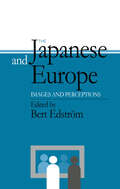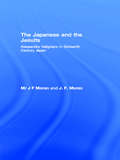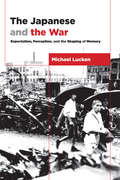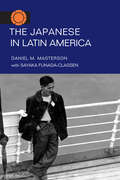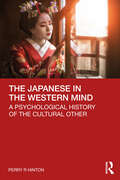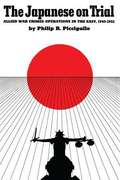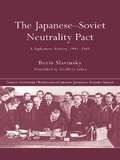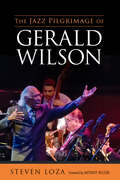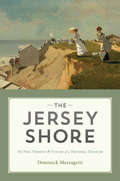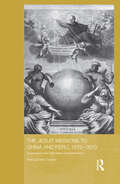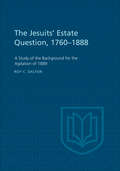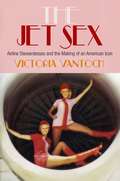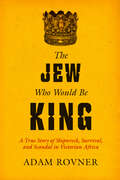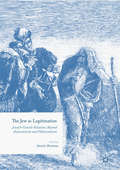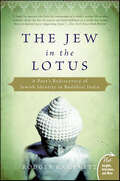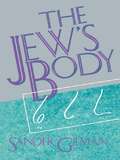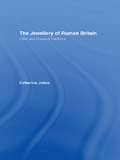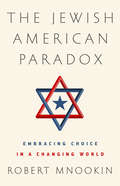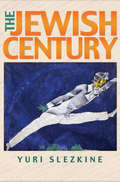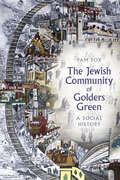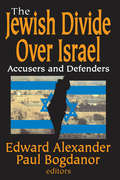- Table View
- List View
The Japanese and Europe: Images and Perceptions
by Bert EdstromNot another 'misunderstandings and misconceptions' volume, but a wide-ranging review of intellectual traditions, mutual and alternative images, and case studies of people and events that mirror the focus of this book.
The Japanese and the Jesuits: Alessandro Valignano in Sixteenth Century Japan
by Mr J Moran J. F. MoranThe Japanese and the Jesuits examines the attempt by sixteenth century Jesuits to convert the Japanese to Christianity. Directing the Jesuits was the Italian Alessandro Valignano, whose own magisterial writings, many of them not previously translated or published, are the principle source material for this account of one of the most remarkable of all meetings between East and West.Valignano arrived in Japan in 1579. In promoting Christianity, he always sought the support of the ruling classes, but an important part of his strategy was also to have the missionaries adapt themselves thoroughly to Japanese customs, etiquette and culture. He was insistent that they must master the Japanese language, and he brought to Japan a European printing press, which turned out grammars and dictionaries for the missionaries, and works of instruction and devotion for the Japanese Christians.Following Valignano's death, Christianity was proscribed and missionaries banished from Japan. This does not detract from his remarkable achievements. He understood perfectly well that foreign missionaries by themselves were not capable of converting Japan to Christianity, and one of his principal concerns was the training of Japanese Jesuits and priests, and breaking down the barriers between them and the Europeans. Few people have ever been more acutely aware of, or grappled more determinedly with, problems in Japanese-Western relationships.
The Japanese and the War: Expectation, Perception, and the Shaping of Memory (Asia Perspectives: History, Society, and Culture)
by Michael LuckenMemories of World War II exert a powerful influence over Japan's culture and society. In The Japanese and the War, Michael Lucken details how World War II manifested in the literature, art, film, funerary practices, and education reform of the time. Concentrating on the years immediately before and after (1937 to 1952), Lucken explores the creation of an idea of Japanese identity that still resonates in everything from soap operas to the response to the Fukushima nuclear disaster.Lucken defines three distinct layers of Japan's memory of World War II: the population's expectations at the beginning, the trauma caused by conflict and defeat, and the politics of memory that arose after Japan lost to the Allied powers. Emphasizing Japanese-language sources, Lucken writes a narrative of the making of Japanese cultural memory that moves away from Western historical modes and perspectives. His approach also paints a new portrait of the U.S. occupation, while still maintaining a cultural focus. Lucken sets out to capture the many ways people engage with war, but particularly the full range of Japan's experiences, which, he argues, the Japanese state has yet to fully confront, leading to a range of tensions at home and abroad.
The Japanese in Latin America (Asian American Experience)
by Daniel M. MastersonLatin America is home to 1.5 million persons of Japanese descent. Combining detailed scholarship with rich personal histories, Daniel M. Masterson, with the assistance of Sayaka Funada-Classen, presents the first comprehensive study of the patterns of Japanese migration on the continent as a whole. When the United States and Canada tightened their immigration restrictions in 1907, Japanese contract laborers began to arrive at mines and plantations in Latin America. The authors examine Japanese agricultural colonies in Latin America, as well as the subsequent cultural networks that sprang up within and among them, and the changes that occurred as the Japanese moved from wage labor to ownership of farms and small businesses. They also explore recent economic crises in Brazil, Argentina, and Peru, which, combined with a strong Japanese economy, caused at least a quarter million Latin American Japanese to migrate back to Japan. Illuminating authoritative research with extensive interviews with migrants and their families, The Japanese in Latin America tells the story of immigrants who maintained strong allegiances to their Japanese roots, even while they struggled to build lives in their new countries.
The Japanese in the Western Mind: A Psychological History of the Cultural Other
by Perry R HintonThis fascinating book is an insightful exploration of Western perceptions and representations of Japanese culture and society, drawing on social and cultural psychological ideas around stereotypes and intercultural relations. Hinton considers how the West views the Japanese as an ideologically different “other”, and proposes a cultural theory of stereotypes from which to explore Western observations of the Japanese. The book explores Western socio-cultural representations of the Japanese alongside Edward Said’s well-known theory of Orientalism. It examines the West’s intercultural relationship with Japan, and how this has changed over time, to show how the Japanese have been represented in the Western mind throughout history, to the present day. Hinton argues that our view of other cultures is based on our own cultural expectations, which involve complex issues of meaning-making and perceived cultural differences. This book foregrounds the research through accounts of Westerners about the Japanese, to reveal how cultural representations can influence the ways in which people from different cultures communicate in interaction, and how intercultural understanding or misunderstanding can arise. By reflecting on the changing Western representations of the Japanese, and how and why these have emerged, this book will be of interest to students, academics and general readers interested in stereotypes, cultural psychology, intercultural communication, anthropology and Japanese culture and history.
The Japanese on Trial: Allied War Crimes Operations in the East, 1945-1951
by Philip R. PiccigalloThis comprehensive treatment of post-World War II Allied war crimes trials in the Far East is a significant contribution to a neglected subject. While the Nuremberg and, to a lesser degree, Tokyo tribunals have received considerable attention, this is the first full-length assessment of the entire Far East operation, which involved some 5,700 accused and 2,200 trials. After discussing the Tokyo trial, Piccigallo systematically examines the operations of each Allied nation, documenting procedure and machinery as well as the details of actual trials (including hitherto unpublished photographs) and ending with a statistical summary of cases. This study allows a completely new assessment of the Far East proceedings: with a few exceptions, the trials were carefully and fairly conducted, the efforts of defense counsel and the elaborate review procedures being especially noteworthy. Piccigallo's approach to this emotion-filled subject is straightforward and evenhanded throughout. He concludes with a discussion of the broader implications of such war crimes trials, a matter of interest to the general reader as well as to specialists in history, law, and international affairs.
The Japanese-Soviet Neutrality Pact: A Diplomatic History 1941-1945 (Nissan Institute/Routledge Japanese Studies)
by Boris SlavinskyThe neutrality pact between Japan and the Soviet Union, signed in April 1941, lapsed only nine months before its expiry date of April 1946 when the Soviet Union attacked Japan. Japan's neutrality had enabled Stalin to move Far Eastern forces to the German front where they contributed significantly to Soviet victories from Moscow to Berlin. Slavinsky suggests that Stalin's agreement with Churchill and Roosevelt to attack Japan after Germany's surrender allowed him to keep Japan in the war until he was ready to attack and thus avenge Russia's defeat in the war of 1904-1905. The Soviet Union's violation of the pact and the detention of Japanese prisoners for up to ten years after the end of the war created a sense of victimization in Japan to the extent that there is still no formal Peace Treaty between the two countries to this day.Slavinsky draws on recently opened Russian archival material to demonstrate that the Soviet Union was passing information about the Allies to Japan during the Second World War. He also persuasively argues that vengeance and the (re)acquistion of land were the primary motives for the attack on Japan. The book contains empirical data previously unavailable in English and will fascinate anyone with an interest in the history of Japan, the Soviet Union and the events of the Second World War.
The Jazz Pilgrimage of Gerald Wilson (American Made Music Series)
by Steven LozaJazz great Gerald Wilson (1918-2014), born in Shelby, Mississippi, left a global legacy of paramount significance through his progressive musical ideas and his orchestra's consistent influence on international jazz. Aided greatly by interviews that bring Wilson's voice to the story, Steven Loza presents a perspective on what the musician and composer called his "jazz pilgrimage."Wilson uniquely adapted Latin influences into his jazz palette, incorporating many Cuban and Brazilian inflections as well as those of Mexican and Spanish styling. Throughout the book, Loza refers to Wilson's compositions and arrangements, including their historical contexts and motivations. Loza provides savvy musical readings and analysis of the repertoire. He concludes by reflecting upon Wilson's ideas on the place of jazz culture in America, its place in society and politics, its origins, and its future.With a foreword written by Wilson's son, Anthony, and such sources as essays, record notes, interviews, and Wilson's own reflections, the biography represents the artist's ideas with all their philosophical, historical, and cultural dimensions. Beyond merely documenting Wilson's many awards and recognitions, this book ushers readers into the heart and soul of a jazz creator. Wilson emerges a unique and proud African American artist whose tunes became a mosaic of the world.
The Jeffersons at Shadwell
by Susan KernMerging archaeology, material culture, and social history, historian Susan Kern reveals the fascinating story of Shadwell, the birthplace of Thomas Jefferson and home to his parents, Jane and Peter Jefferson, their eight children, and over sixty slaves. Located in present-day Albemarle County, Virginia, Shadwell was at the time considered "the frontier. " However, Kern demonstrates that Shadwell was no crude log cabin; it was, in fact, a well-appointed gentry house full of fashionable goods, located at the center of a substantial plantation. Kern's scholarship offers new views of the family's role in settling Virginia as well as new perspectives on Thomas Jefferson himself. By examining a variety of sources, including account books, diaries, and letters, Kern re-creates in rich detail the daily lives of the Jeffersons at Shadwell--from Jane Jefferson's cultivation of a learned and cultured household to Peter Jefferson's extensive business network and oversight of a thriving plantation. Shadwell was Thomas Jefferson's patrimony, but Kern asserts that his real legacy there came from his parents, who cultivated the strong social connections that would later open doors for their children. At Shadwell, Jefferson learned the importance of fostering relationships with slaves, laborers, and powerful office holders, as well as the hierarchical structure of large plantations, which he later applied at Monticello. The story of Shadwell affects how we interpret much of what we know about Thomas Jefferson today, and Kern's fascinating book is sure to become the standard work on Jefferson's early years.
The Jersey Shore: The Past, Present & Future of a National Treasure
by Dominick MazzagettiIn The Jersey Shore, Dominick Mazzagetti provides a modern re-telling of the history, culture, and landscapes of this famous region, from the 1600s to the present. The Shore, from Sandy Hook to Cape May, became a national resort in the late 1800s and contributes enormously to New Jersey’s economy today. The devastation of Hurricane Sandy in 2012 underscored the area’s central place in the state’s identity and the rebuilding efforts after the storm restored its economic health. Divided into chronological and thematic sections, this book will attract general readers interested in the history of the Shore: how it appeared to early European explorers; how the earliest settlers came to the beaches for the whaling trade; the first attractions for tourists in the nineteenth century; and how the coming of railroads, and ultimately automobiles, transformed the Shore into a major vacation destination over a century later. Mazzagetti also explores how the impact of changing national mores on development, race relations, and the environment, impacted the Shore in recent decades and will into the future. Ultimately, this book is an enthusiastic and comprehensive portrait by a native son, whose passion for the region is shared by millions of beachgoers throughout the Northeast.
The Jesuit Missions to China and Peru, 1570-1610: Expectations and Appraisals of Expansionism (Routledge Studies in the Modern History of Asia)
by Ana Carolina HosneThe rulers of the overseas empires summoned the Society of Jesus to evangelize their new subjects in the ‘New World’ which Spain and Portugal shared; this book is about how two different missions, in China and Peru, evolved in the early modern world. From a European perspective, this book is about the way Christianity expanded in the early modern period, craving universalism. In China, Matteo Ricci was so impressed by the influence that the scholar-officials were able to exert on the Ming Emperor himself that he likened them to the philosopher-kings of Plato’s Republic. The Jesuits in China were in the hands of the scholar-officials, with the Emperor at the apex, who had the power to decide whether they could stay or not. Meanwhile, in Peru, the Society of Jesus was required to impose Tridentine Catholicism by Philip II, independently of Rome, a task that entailed compliance with the colonial authorities’ demands. This book explores how leading Jesuits, Matteo Ricci (1552-1610) in China and José de Acosta (1540-1600) in Peru, envisioned mission projects and reflected them on the catechisms they both composed, with a remarkable power of endurance. It offers a reflection on how the Jesuits conceived and assessed these mission spaces, in which their keen political acumen and a certain taste for power unfolded, playing key roles in envisioning new doctrinal directions and reflecting them in their doctrinal texts.
The Jesuits' Estate Question, 1760-1888: A Study of the Background for the Agitation of 1889 (Canadian Studies in History and Government #11)
by Roy DaltonMore than a hundred years of trouble followed the land grant of half a million acres along the St. Lawrence River to the Jesuits. The history of this land is a turbulent one that involved every area of colonial settlement and finally threatened Confederation. In 1888 the Quebec legislature passed an "Act Respecting the Settlement of the Jesuits' Estates": the result was a storm of protest that came close to shattering the union of the provinces. At the time of this Act there was no balanced historical account of the Jesuits' estates. nor until this one has there been any subsequent study that has ever begun to explore their tangled history. Professor Dalton provides a badly needed investigation into this area of Canadian history: his work is unbiased and thorough and offers new material for a reappraisal of this century of our past. (Canadian Studies in History and Government, No. 11.)
The Jet Sex
by Victoria VantochIn the years after World War II, the airline stewardess became one of the most celebrated symbols of American womanhood. Stewardesses appeared on magazine covers, on lecture circuits, and in ad campaigns for everything from milk to cigarettes. Airlines enlisted them to pose for publicity shots, mingle with international dignitaries, and even serve (in sequined minidresses) as the official hostesses at Richard Nixon's inaugural ball. Embodying mainstream America's perfect woman, the stewardess was an ambassador of femininity and the American way both at home and abroad. Young, beautiful, unmarried, intelligent, charming, and nurturing, she inspired young girls everywhere to set their sights on the sky.In The Jet Sex, Victoria Vantoch explores in rich detail how multiple forces--business strategy, advertising, race, sexuality, and Cold War politics--cultivated an image of the stewardess that reflected America's vision of itself, from the wholesome girl-next-door of the 1940s to the cosmopolitan glamour girl of the Jet Age to the sexy playmate of the 1960s. Though airlines marketed her as the consummate hostess--an expert at pampering her mostly male passengers, while mixing martinis and allaying their fears of flying--she bridged the gap between the idealized 1950s housewife and the emerging "working woman." On the international stage, this select cadre of women served as ambassadors of their nation in the propaganda clashes of the Cold War. The stylish Pucci-clad American stewardess represented the United States as middle class and consumer oriented--hallmarks of capitalism's success and a stark contrast to her counterpart at Aeroflot, the Soviet national airline. As the apotheosis of feminine charm and American careerism, the stewardess subtly bucked traditional gender roles and paved the way for the women's movement. Drawing on industry archives and hundreds of interviews, this vibrant cultural history offers a fresh perspective on the sweeping changes in twentieth-century American life.
The Jew Who Would Be King: A True Story of Shipwreck, Survival, and Scandal in Victorian Africa
by Adam Laurence Rovner"Brings the nineteenth century to life, with its attendant disease, violence, and colonial machinations."—Jewish Book Council "In Rovner's deeply researched biography, the adventurer's swashbuckling memoirs are. . . . a crowbar of sorts, used to pry open a window onto an era of possibility, prejudice and burgeoning colonial avarice."—NPRThis vivid reconstruction of one man’s life reveals the harsh realities and moral ambiguities of colonial power. The Jew Who Would Be King tells the story of Nathaniel Isaacs—a nineteenth-century British Jew who helped establish the Zulu kingdom only to become a ruthless warlord and slaveholder. Isaacs’ thrilling journey begins with his shipwreck on the shores of Zululand and proceeds to ports across West Africa, including Freetown, Sierra Leone. There, tasked by the colonial governor to end the local slave trade, Isaacs brokered deals that reinforced his own power. Adam Rovner's meticulous archival research in England, Sierra Leone, South Africa, and St. Helena, coupled with his own travels to the remnants of Isaacs’ island stronghold in Guinea, brings this complex figure to life. Through Isaacs’ story, Rovner exposes the entangled forces of Jewish emancipation and antisemitism, slavery and abolition, the stark dichotomies of civilization and "savagery," and the creation of whiteness versus Blackness.
The Jew as Legitimation
by David J. WertheimThis book traces the historical phenomenon of "the Jew as Legitimation. " Contributors discuss how Jews have been used, through time, to validate non-Jewish beliefs. The volume dissects the dilemmas and challenges this pattern has presented to Jews. Throughout history, Jews and Judaism have served to legitimize the beliefs of Gentiles. Jews functioned as Augustine's witnesses to the truth of Christianity, as Christian Kabbalist's source for Protestant truths, as an argument for the enlightened claim for tolerance, as the focus of modern Christian Zionist reverence, and as a weapon of contemporary right wing populism against fears of Islamization. This volume challenges understandings of Jewish-Gentile relations, offering a counter-perspective to discourses of antisemitism and philosemitism.
The Jew in the Lotus: A Poet's Rediscovery of Jewish Identity in Buddhist India
by Rodger KamenetzWhile accompanying eight high–spirited Jewish delegates to Dharamsala, India, for a historic Buddhist–Jewish dialogue with the Dalai Lama, poet Rodger Kamenetz comes to understand the convergence of Buddhist and Jewish thought. Along the way he encounters Ram Dass and Richard Gere, and dialogues with leading rabbis and Jewish thinkers, including Zalman Schacter, Yitz and Blue Greenberg, and a host of religious and disaffected Jews and Jewish Buddhists. This amazing journey through Tibetan Buddhism and Judaism leads Kamenetz to a renewed appreciation of his living Jewish roots.
The Jew's Body
by Sander GilmanDrawing on a wealth of medical and historical materials, Sander Gilman sketches details of the anti-Semitic rhetoric about the Jewish body and mind, including medical and popular depictions of the Jewish voice, feet, and nose. Case studies illustrate how Jews have responded to such public misconceptions as the myth of the cloven foot and Jewish flat-footedness, the proposed link between the Jewish mind and hysteria, and the Victorians' irrational connection between Jews and prostitutes. Gilman is especially concerned with the role of psychoanalysis in the construction of anti-Semitism, examining Freud's attitude towards his own Jewishness and its effect on his theories, as well as the supposed "objectiveness" of psychiatrists and social scientists.
The Jewellery Of Roman Britain: Celtic and Classical Traditions
by Dr Catherine Johns Catherine JohnsThis work provides a survey of the jewellery of Roman Britain. Fully illustrated and accessible to both the specialist and amateur enthusiast, it surveys the full range of personal ornament worn in Britain during the Roman period, the 1st to 4th centuries AD. It emphasizes the presence of two distinct cultural and artistic traditions, the classical element introduced by the Romans and the indigeneous Celtic background. The interaction of these traditions affected all aspects of Romano-British life and is illustrated in the jewellery.; The meaning and significance of personal ornament in a wide range of cultures is discussed, including such matters as symbolism and the display of wealth and status. The principal types of Romano-British jewellery are classified in detail, drawing attention to those which can be relatively closely dated. The coverage is not restricted to precious-metal objects, but includes jewellery made of base metals and materials such as bone, jet and glass. The final chapter is devoted to the techniques of manufacture, a subject which has become better understood in recent years as a result of scientific advances. The book should appeal to anyone who practices, teaches or studies Roman archaeology, together with all those with a professional or amateur interest in the history of jewellery and design.
The Jewish American Paradox: Embracing Choice in a Changing World
by Robert H. MnookinWho should count as Jewish in America? What should be the relationship of American Jews to Israel? Can the American Jewish community collectively sustain and pass on to the next generation a sufficient sense of Jewish identity? The situation of American Jews today is deeply paradoxical. Jews have achieved unprecedented integration, influence, and esteem in virtually every facet of American life. But this extraordinarily diverse community now also faces four critical and often divisive challenges: rampant intermarriage, weak religious observance, diminished cohesion in the face of waning anti-Semitism, and deeply conflicting views about Israel.Can the American Jewish community collectively sustain and pass on to the next generation a sufficient sense of Jewish identity in light of these challenges? Who should count as Jewish in America? What should be the relationship of American Jews to Israel?In this thoughtful and perceptive book, Robert H. Mnookin argues that the answers of the past no longer serve American Jews today. The book boldly promotes a radically inclusive American-Jewish community--one where being Jewish can depend on personal choice and public self-identification, not simply birth or formal religious conversion. Instead of preventing intermarriage or ostracizing those critical of Israel, he envisions a community that embraces diversity and debate, and in so doing, preserves and strengthens the Jewish identity into the next generation and beyond.
The Jewish Century
by Yuri SlezkineThis masterwork of interpretative history begins with a bold declaration: The Modern Age is the Jewish Age--and we are all, to varying degrees, Jews. The assertion is, of course, metaphorical. But it underscores Yuri Slezkine's provocative thesis. Not only have Jews adapted better than many other groups to living in the modern world, they have become the premiere symbol and standard of modern life everywhere. Slezkine argues that the Jews were, in effect, among the world's first free agents. They traditionally belonged to a social and anthropological category known as "service nomads," an outsider group specializing in the delivery of goods and services. Their role, Slezkine argues, was part of a broader division of human labor between what he calls Mercurians-entrepreneurial minorities--and Apollonians--food-producing majorities. Since the dawning of the Modern Age, Mercurians have taken center stage. In fact, Slezkine argues, modernity is all about Apollonians becoming Mercurians--urban, mobile, literate, articulate, intellectually intricate, physically fastidious, and occupationally flexible. Since no group has been more adept at Mercurianism than the Jews, he contends, these exemplary ancients are now model moderns. The book concentrates on the drama of the Russian Jews, including émigrés and their offspring in America, Palestine, and the Soviet Union. But Slezkine has as much to say about the many faces of modernity--nationalism, socialism, capitalism, and liberalism--as he does about Jewry. Marxism and Freudianism, for example, sprang largely from the Jewish predicament, Slezkine notes, and both Soviet Bolshevism and American liberalism were affected in fundamental ways by the Jewish exodus from the Pale of Settlement. Rich in its insight, sweeping in its chronology, and fearless in its analysis, this sure-to-be-controversial work is an important contribution not only to Jewish and Russian history but to the history of Europe and America as well.
The Jewish Century, New Edition
by Yuri SlezkineThis masterwork of interpretative history begins with a bold declaration: “The Modern Age is the Jewish Age, and the twentieth century, in particular, is the Jewish Century.” The assertion is, of course, metaphorical. But it drives home Yuri Slezkine’s provocative thesis: Jews have adapted to the modern world so well that they have become models of what it means to be modern. While focusing on the drama of the Russian Jews, including émigrés and their offspring, The Jewish Century is also an incredibly original account of the many faces of modernity—nationalism, socialism, capitalism, and liberalism. Rich in its insight, sweeping in its chronology, and fearless in its analysis, this is a landmark contribution to Jewish, Russian, European, and American history.
The Jewish Community of Golders Green: A Social History
by Pam FoxThe first Jews settled in Golders Green just before the First World War, and by 1930 the suburb had been recognised for its significant Jewish community. By 1960 the Jewish population of Golders Green had tripled. A century after the arrival of the first Jewish families, the community remains very diverse and is growing rapidly. Golders Green is now the most Jewishly populous neighbourhood in the country. Despite its prominence and its vibrancy, the Jewish Community of Golders Green have not been the subject of a detailed historical study. This book addresses this oversight and – based to a significant extent on the memories and knowledge of the community – fills an important gap in Anglo-Jewish history.
The Jewish Condition: Challenges and Responses - 1938-2008
by William B. HelmreichThis brilliant set of essays poses the paradigm question: are Jews in grave danger today or not? Concern is rooted in the storm clouds of 1938, when the same question arose just prior to the outbreak of the Second World War and the Holocaust. The contributors do not presume that the events of seventy years ago are identical with those today, or that they emanate from the same sources. However, the shared feeling is that Jewish communities worldwide are very much, once again at risk.In post 1938 Germany, the Nazi state began its march toward world conquest, with the destruction of European Jewry as its centerpiece. In an act of willful blindness, Western democratic leaders chose to negotiate and appease the Hitler regime. Many Jewish leaders also chose to minimize the risks. Seven years later, over 50 million people, including six million Jews had been liquidated. In 2008 extremist Islamic forces have spawned a global Jihad. State sponsored terrorism, a war against the West as well as against moderate Islamic states, once again holds the destruction of the Jewish people, and in particular the State of Israel, as a critical goal. The Iranian leadership proclaims that "a world without America and Israel is both possible and feasible."Against such a diplomatic and historical background a conference was organized resulting in these essays written by Alan Dershowitz, Norman Podhoretz, Michael Walzer, Leonard Fein and David Price-Jones. The results are varied at the policy level, but unified in appreciator of a disturbing revival of inherited hatred and anti-Semitic outbreaks against Jews both within and outside of Europe. This is a compelling effort that merits the attention of social scientists, policy-makers, and those interested in international relations.
The Jewish Cultural Tapestry: International Jewish Folk Traditions
by Steven M. LowensteinFilled with fascinating facts and keen insights, The Jewish Cultural Tapestry is a richly woven fabric that vividly captures the diversity of Jewish life. All traditional Jews are bound together by the common thread of the Torah and the Talmud, notes author Steven Lowenstein, but this thread takes on a different coloration in different parts of the world as Jewish tradition and local non-Jewish customs intertwine. Lowenstein describes these widely varying regional Jewish cultures with needlepoint accuracy, highlighting the often surprising similarities between Jewish and non-Jewish local traditions, and revealing why Jewish customs vary as much as they do from region to region. From Europe to India, Israel to America, The Jewish Cultural Tapestry offers an engaging overview of the customs and folkways of a people united by tradition, yet scattered to the far corners of the earth.
The Jewish Divide Over Israel: Accusers and Defenders
by Paul BogdanorBefore 1967, Israel had the overwhelming support of world opinion. So long as Israel's existence was in harmony with politically correct assumptions, it was supported, or at least accepted, by the majority of "progressive" Jews, especially in the wake of the Holocaust. This is no longer the case. "The Jewish Divide Over Israel" explains the role played by prominent Jews in turning Israel into an isolated pariah nation. After their catastrophic defeat in 1967, Arabs overcame inferiority on the battlefield with superiority in the war of ideas. Their propaganda stopped trumpeting their desire to eradicate Israel. Instead, in a calculated appeal to liberals and radicals, they redefined their war of aggression against the Jews as a struggle for the liberation of Palestinian Arabs. The tenacity of Arabs' rejection of Israel and their relentless campaign - in schools, universities, churches, professional organizations, and, above all, the news media - to destroy Israel's moral image had the desired impact. Many Jewish liberals became desperate to escape from the shadow of Israel's alleged misdeeds and found a way to do so by joining other members of the left in blaming Israeli sins for Arab violence. Today, Jewish liberals rationalize violence against the innocent as resistance to the oppressor, excuse Arab extremism as the frustration of a wronged party, and redefine eliminationist rhetoric and physical assaults on Jews as "criticism of Israeli policy." Israel's Jewish accusers have played a crucial and disproportionate role in the current upsurge of antisemitism precisely because they speak as Jews. The essays in this book seek to understand and throw back the assault on Israel led by such Jewish liberals and radicals as Tony Judt, Noam Chomsky, George Steiner, Daniel Boyarin, Marc Ellis, Israel Shahak, and many others. Its writers demonstrate that the foundation of the state of Israel, far from being the primal sin alleged by its accusers, was one of the few redeeming events in a century of blood and shame.
